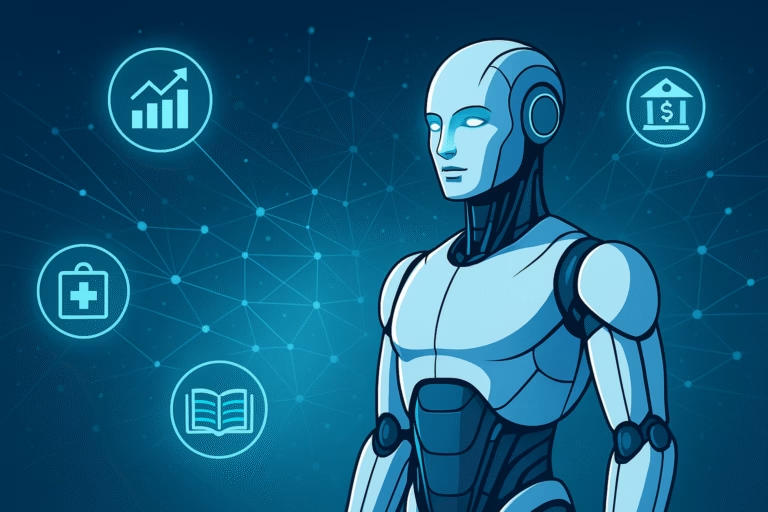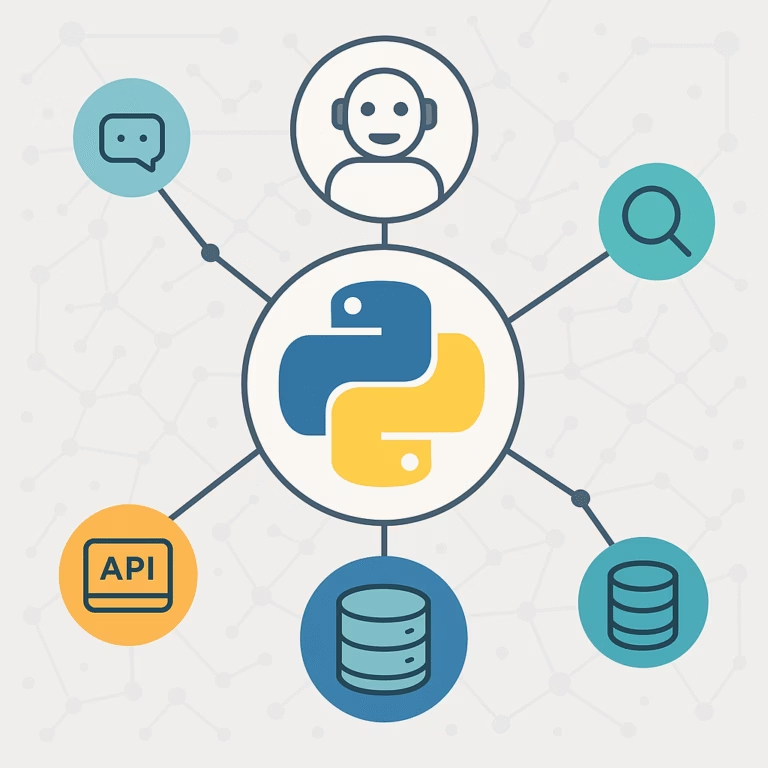How to Develop AI Agents Using Python (2025 Guide)
Artificial Intelligence has evolved beyond simple chatbots and predictive models. Today, AI agents represent a new frontier: autonomous systems that can reason, plan, use tools, and interact with environments to achieve goals. Thanks to Python’s rich ecosystem of libraries, anyone with intermediate coding skills can start building such agents.
In this guide, we’ll walk through how to develop AI agents using Python, including frameworks, code examples, architectural principles, and deployment strategies.
- What Are AI Agents?
- Why Use Python for AI Agents?
- Core Components of an AI Agent
- Popular Frameworks for Building AI Agents in Python
- Step-by-Step Guide to Building Your First Agent
- Adding Memory and Knowledge Retrieval
- Using Reinforcement Learning for Smarter Agents
- Best Practices and Common Pitfalls
- Deployment and Scaling AI Agents
- Final Thoughts
What Are AI Agents?
At its core, an AI agent is a program that perceives its environment, decides what actions to take, and executes them to achieve specific goals. Unlike traditional software that follows rigid instructions, agents can adapt dynamically.
For example:
- A customer-support agent can retrieve knowledge base answers, escalate issues, and schedule callbacks.
- A research agent can browse the web, extract summaries, and generate reports.
- A trading agent can analyze financial data, run simulations, and place trades (with safety guardrails).
Transitioning from simple automation scripts to intelligent agents is what makes them powerful.
Why Use Python for AI Agents?
Python remains the go-to language for AI because:
- Vast libraries like LangChain, Hugging Face, Ray, Transformers.
- Easy integration with OpenAI, Anthropic, Google Gemini APIs.
- Strong ecosystem for data science, ML, and backend development.
- Large developer community, ensuring quick support and abundant tutorials.
This makes Python ideal for experimenting with both lightweight prototypes and production-grade AI agents.
Core Components of an AI Agent
Every AI agent typically has:
- Agent Loop – the reasoning cycle (observe → decide → act → reflect).
- Tools – APIs, databases, calculators, or custom functions the agent can call.
- Memory – short-term and long-term storage of interactions.
- LLM or Model Backend – the intelligence engine (e.g., GPT, Llama, Mistral).
- Safety/Guardrails – filters and validators for outputs and tool usage.
- Deployment Layer – cloud, container, or local environment where the agent runs.
Popular Frameworks for Building AI Agents in Python
Here are the most widely used frameworks as of 2025:
- LangChain / LangGraph – Tool orchestration and multi-agent support.
- OpenAI Agents SDK – Clean APIs for building agents with GPT models.
- Hugging Face smolagents – Lightweight framework for local & HF-hosted models.
- Ray RLlib & Serve – For reinforcement learning agents and scaling.
Each framework has trade-offs: OpenAI SDK is simple but tied to GPT; LangChain is flexible but heavier; Hugging Face is good for open-source models.
Step-by-Step Guide to Building Your First Agent
Step 1: Install Dependencies
pip install langchain openaiStep 2: Define Tools
from langchain.agents import Tool
def calculator(expression: str) -> str:
try:
return str(eval(expression))
except Exception as e:
return f"Error: {e}"
calc_tool = Tool(
name="Calculator",
func=calculator,
description="Performs basic math operations."
)Step 3: Create Agent with LLM
from langchain.llms import OpenAI
from langchain.agents import initialize_agent
llm = OpenAI(temperature=0)
agent = initialize_agent([calc_tool], llm, agent="zero-shot-react-description")
print(agent.run("What is 42 * 19?"))This agent now understands queries and decides when to call the calculator tool.
Adding Memory and Knowledge Retrieval
Agents without memory feel “forgetful.” To make them smarter:
- Short-term memory: store chat history.
- Long-term memory: embed text using vector databases (Chroma, Pinecone, Weaviate).
- Retrieval-Augmented Generation (RAG): fetch relevant knowledge before LLM response.
from langchain.memory import ConversationBufferMemory
memory = ConversationBufferMemory()
agent_with_memory = initialize_agent([calc_tool], llm, memory=memory)Using Reinforcement Learning for Smarter Agents
Some agents need to learn from trial and error (e.g., trading bots, robotics).
Python offers:
- RLlib (Ray) – distributed reinforcement learning.
- Stable Baselines3 – simpler RL algorithms for agents.
Agents can optimize decisions through rewards rather than just instructions.
Best Practices and Common Pitfalls
✅ Always validate tool inputs (avoid unsafe code execution).
✅ Add rate limits & guardrails to prevent abuse.
✅ Monitor logs to debug unexpected agent actions.
✅ Keep context windows small; use retrieval for large knowledge.
❌ Don’t give agents unrestricted shell/file access.
❌ Avoid making agents too complex before nailing down simple workflows.
Deployment and Scaling AI Agents
For production:
- Containerize with Docker.
- Deploy with Ray Serve, AWS Lambda, or FastAPI.
- Add observability (logging, tracing, monitoring).
- Scale horizontally with autoscaling clusters.
Agents often require balancing latency, cost, and reliability.
Final Thoughts
AI agents built in Python are transforming industries — from customer support to autonomous research. With frameworks like LangChain, OpenAI Agents SDK, Hugging Face, and Ray, developers can now build systems that reason, plan, and act.
Whether you’re a hobbyist experimenting at home or an engineer deploying enterprise-scale agents, the roadmap is clear:
Start small → add tools → integrate memory → apply guardrails → deploy at scale.
Python makes this journey approachable and powerful.



One Comment